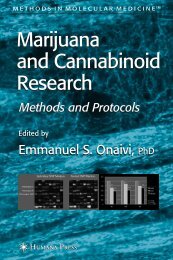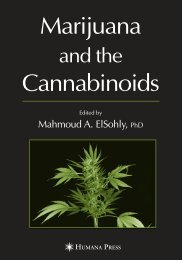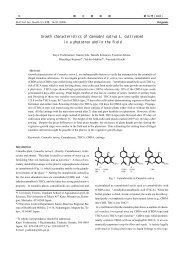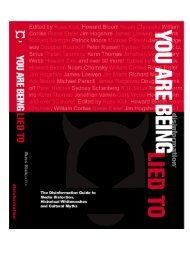Psychedelic Chemistry - Hampapartiet
Psychedelic Chemistry - Hampapartiet
Psychedelic Chemistry - Hampapartiet
- No tags were found...
You also want an ePaper? Increase the reach of your titles
YUMPU automatically turns print PDFs into web optimized ePapers that Google loves.
<strong>Psychedelic</strong> <strong>Chemistry</strong> - Mescaline and Friendsportionwise and filter, evaporate in vacuum to get about 100% yield of (II). Heat 2 g (II) in 20 ml aqueous HCl for four hours andcool, precipitate, filter, evaporate in vacuum the filtrate to get about 30% yield mescaline.Phenethylamines JMC 15,214(1972)This is a rapid, convenient procedure. If trimethoxybenzyl alcohol is used in place of p-anisyl alcohol, mescaline will result. Shake100 g p-anisyl alcohol (or 0.72 moles analog) with 500 ml concentrated HCl for 2 minutes. Wash the organic phase with water, 5%NaHCO3 and water, and then add over 40 minutes to a stirred slurry of 49 g NaCN in 400 ml dimethylsulfoxide with ice watercooling to keep temperature at 35-40ø. After completing addition, remove cooling bath, stir for 90 minutes and then add to 300 mlwater. Separate the small upper layer and extract the aqueous-DMSO layer with 2x100 ml ether. Add the ether extracts to the smallupper layer, wash once with water and dry (MgSO4). Add 600 ml ether to a dry flask and chill in ice as 80 g of anhydrous AlCl3, isadded portionwise, followed by 23 g of lithium aluminum hydride. Add the washed and dried ether extracts at such a rate as to givegentle reflux without external heat (ca. 1 hour). Stir for 2 hours, ice chill and treat dropwise with 25 ml water then 250 ml 20%aqueous NaOH, with periodic addition of ether through the condenser to replenish losses and facilitate stirring. Filter and washprecipitate with ether; add ether to filtrate and mix with one third its volume of absolute ethanol. Slowly and with continuousswirling and ice cooling add 60 ml concentrated HCl. Cool to 0ø and filter to get the amine hydrochloride in ca. 75% overall yield(or can obtain the crude amine by filtering and drying, evaporating in vacuum the final ether solution). Note the use of concentratedHCl to obtain the crystalline end product in contrast to many other papers which employ HCl gas.N-Methylation of Amines JMC 13,134(1970), 15,214(1972)Either phenethylamine or phenylisopropylamine will work. If the hydrochloride salt is available, this should first be changed to thefree amine by stirring with concentrated aqueous NaOH.Treat 0.54 moles of the amine with 100 ml of benzene and 70 g of benzaldehyde in a flask fitted with a Dean-Stark trap and refluxuntil no more water is present in the condensate (ca. 1 hour) (alternatively, reflux 1/2 hour and then distill until the temperaturereaches 100ø): remove the trap and add a solution of 82 g dimethylsulfate in 200 ml benzene through the condenser at a ratesufficient to maintain reflux (ca. 15 minutes). Reflux 30 minutes (or heat 90 minutes on a steam bath), add 200 ml water and reflux(or heat on steam bath) for 1/2 hour more. Separate the aqueous layer, extract it twice with ether or benzene, basify with 50% NaOHand extract twice more. Add the extracts to the organic layer and dry, evaporate in vacuum to get ca. 70% yield of the N-methylamine.Can crystallize by dissolving in 500 ml 20% absolute ethanol-ether and treating with 50 ml concentrated HCl while swirlingand cooling. The crystals can be further purified by washing with ice cold 20% ethanol-ether and recrystallizing from ethanol.N-methylation of hallucinogenic amphetamines seems to produce a very smooth, mellow, euphoric trip, and the same is probablytrue for phenylethylamines. For N-methylation via the imides see JOC 38, I 348(1973). N-methylation appears to decrease thepotency. Larger N-alkyl groups seem to have a sedative action.N,N-Dimethylamines JMC 13,134(1970)To 14 g formic acid, cooled in an ice water bath, add dropwise 0.016 mole of the amine and then 3.6 g of formaldehyde (ca.10 ml offormalin) and reflux for 5 hours. Cool to room temperature, add 7 ml concentrated HCl and evaporate in vacuum. The resulting oilydimethylamine can be purified by dissolving in 25 ml water, extracting with 2x25 ml CHCl3. Basify the aqueous layer with 2NNaOH and extract with 3x25 ml ether, and proceed as described above for the N-methylamines. This procedure should work forboth phenethylamines and phenylisopropylamines, and should affect the trip similarly to N-monomethylation. See the followingmethod for another easy route to N-alkylation which will probably work for dialkylation. Although N,N dialkyl compounds havevery little activity, they are probably worth further investigation.Amphetamines via phenylacetones CT 3,313(1968) CF. JACS 58,1808(1936) and JCS18(1930)Note that the following procedure leads from the aldehyde to the amine or N-substituted amine without involving a troublesomecatalytic hydrogenation for reducing the intermediate nitropropene. Mix 0.25M substituted benzaldehyde, 0.3M nitroethane, 50 mlfile:///L:/e-books/psychedelicchemistry/chapter4.html (8 of 10) [02.09.2007 14:38:06]






